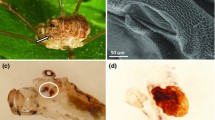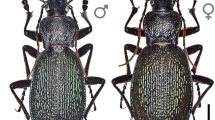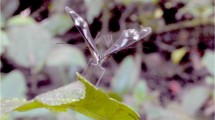Abstract
Nine compounds were detected in three different millipede species: Polydesmus complanatus (L.), Brachydesmus (Stylobrachydesmus) avalae Ćurčić & Makarov, and Brachydesmus (Stylobrachydesmus) dadayi Verhoeff. Benzaldehyde, benzyl alcohol, benzoylnitrile, benzyl methyl ketone, benzoic acid, benzyl ethyl ketone, mandelonitrile, and mandelonitrile benzoate were identified by GC-FID and GC-MS analyses. Hydrogen cyanide was detected qualitatively by the picric acid test. Benzyl ethyl ketone, benzyl methyl ketone, and benzyl alcohol were detected for the first time in polydesmidan millipedes. Benzoylnitrile was the major component in all three hexane extracts. These compounds are suspected to be active in the defensive secretions of these millipede species.

Similar content being viewed by others
References
CASNATI, G., NENCINI, G., QUILICO, A., PAVAN, M., RICCA, A., and SALVATORI, T. 1963. The secretion of the myriapod Polydesmus collaris collaris (Koch). Experientia 19:409–411.
CONNER, W. E., JONES, T. H., EISNER, T., and MEINWALD, J. 1977. Benzoyl cyanide in the defensive secretion of a polydesmoid millipede. Experientia 33:206–207.
DUFFEY, S. S., BLUM, M. S., FALES, H. M., EVANS, S. L., RONCARDI, R. W., TIEMANN, D. L., and NAKAGAWA, Y. 1977. Benzoyl cyanide and mandelonitrile benzoate in the defensive secretions of millipedes. J. Chem. Ecol. 3:101–113.
EISNER, H. E., WOOD, W. F., and EISNER, T. 1975. Hydrogen cyanide production in North American and African polydesmoid millipeds. Psyche 82:20–23.
ENGHOFF, H., and KIME, R. D. (ed.). 2005. Fauna Europaea. Myriapoda. Fauna Europaea, version 1.2. Available from http://www.faunaeur.org.
HOFFMAN, R. L. 1979. Classification of the Diplopoda. p. 237. Muséum d’Histoire Naturelle, Genéve.
HOPKIN, S. P., and READ, J. H. 1992. The Biology of Millipedes. Oxford University Press, Oxford, UK. p. 248.
KUWAHARA, Y., OMURA, H., and TANABE, T. 2002. 2-Nitroethenylbenzenes as natural products in millipede defense secretions. Naturwissenschaften 89:308–310.
MORI, N., KUWAHARA, Y., YOSHIDA, T., and NISHIDA, R. 1994. Identification of benzaldehyde, phenol and mandelonitrile from Epanerchodus japonicus Carl (Polydesmida: Polydesmidae) as possible defense substances. Appl. Entomol. Zool. 29:517–522.
MORI, N., KUWAHARA, Y., YOSHIDA, T., and NISHIDA, R. 1995. Major defensive cyanogen from Parafontaria laminata armigera Verhoeff (Xystodesmidae: Polydesmida). Appl. Entomol. Zool. 30:197–202.
NOGUCHI, S., MORI, N., HIGA, Y., and KUWAHARA, Y. 1997. Identification of Nedyopus patrioticus patrioticus (Attems, 1898) (Polydesmida: Paradoxosomatidae) secretions as possible defense substances. Appl. Entomol. Zool. 32:447–452.
OMURA, H., KUWAHARA, Y., and TANABE, T. 2002a. 1-Octen-3-ol together with geosmin: new secretion compounds from a polydesmid millipede, Niponia nodulosa. J. Chem. Ecol. 28:2601–2612.
OMURA, H, KUWAHARA, Y., and TANABE, T. 2002b. Species-specific chemical composition of defense secretions from Parafontaria tonominea Attems and Riukiaria semicircularis semicircularis Takakuwa (Polydesmida: Xystodesmidae). Appl. Entomol. Zool. 37:73–78.
RONCARDI, R. W., DUFFEY, S. S., and BLUM, M. S. 1985. Antifungal activity of defensive secretions of certain millipedes. Mycologia 77:185–191.
SHEAR, W. A., JONES, T. H., and MIRAS, H. M. 2007. A possible phylogenetic signal in millipede chemical defenses: The polydesmidan millipede Leonardesmus injucundus Shelley & Shear secretes p-cresol and lacks a cyanogenic defense (Diplopoda, Polydesmida, Nearctodesmidae). Biochem. Syst. Ecol. 35:838–842.
STRASSER, K. 1971. Über Diplopoden Jugoslawiens. Senckenberg. Biol. 52:313–345.
Van DEN DOOL, H., and KRATZ, P. D. 1963. A generalization of the retention index system including linear temperature programmed gas-liquid partition chromatography. J. Chromatogr. 11:463–471.
WOOD, W. F., and SORENSEN, P. W. 2005. The defensive secretion of the millipede, Nearctodesmus salix (Polydesmida: Nearctodesmidae). Biochem. Syst. Ecol. 33:1077–1079.
ZAGROBELNY, M., SOREN, B., and MOLLER, B. L. 2008. Cyanogenesis in plants and arthropods. Phytochemistry 69:1457–1468.
Acknowledgments
We thank Steven Seybold (USA) and two anonymous reviewers, whose comments greatly improved the manuscript. This study was supported by the Ministry of Science and Technological Development of Serbia (Grants Nos. 143053 and 142053).
Author information
Authors and Affiliations
Corresponding author
Electronic Supplementary Material
Below is the link to the electronic supplementary material.
Supplemental Data
(DOC 36 kb)
Supplemental Data Fig. 1
Identification of Compound 3. (a) EI MS spectrum of Compound 3 with proposed fragmentation, (b) EI MS spectrum of Compound 3 and library spectrum oriented from head to tail, (c) EI MS library spectrum from Wiley 07 NIST 05 database, with chemical structures. (GIF 69 kb)
Supplemental Data Fig. 2
Identification of Compound 7. (a) EI MS spectrum of Compound 7 with proposed fragmentation, (b) EI MS spectrum of Compound 7 and library spectrum oriented from head to tail, (c) EI MS library spectrum from Wiley 07 NIST 05 database, with chemical structures. (GIF 78 kb)
Supplemental Data Table 1
Chemical composition of the defensive secretions in three polydesmid millipede species analyzed by GC-FID and GC-MS with data from the literature (DOC 55 kb)
Rights and permissions
About this article
Cite this article
Makarov, S.E., Ćurčić, B.P.M., Tešević, V.V. et al. Defensive Secretions in Three Species of Polydesmids (Diplopoda, Polydesmida, Polydesmidae). J Chem Ecol 36, 978–982 (2010). https://doi.org/10.1007/s10886-010-9847-6
Received:
Revised:
Accepted:
Published:
Issue Date:
DOI: https://doi.org/10.1007/s10886-010-9847-6




